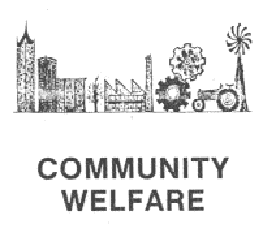
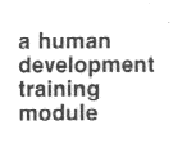
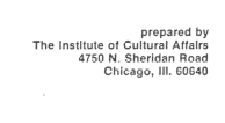
Note: Several modules were presented in this same style to U.S. Aid as a method of documentation.
Not presented on this CD.

| |||
 | |||

|
Note: Several modules were presented in this same style to U.S. Aid as a method of documentation. Not presented on this CD. | ||
| Introduction
I. MODULE DEVELOPMENT A. Background B. Approach
C. Objectives
II. MODULE PREPARATION A. Research Workshop B. Participant Recruitment C. Module Leadership
D. Practical Arrangements
III. MODULE DESIGN A. Module Overview B. Field Visit C. Implementation Talk D. Resource Panel E. Implementation Workshop
F. Participant Evaluation
IV. BACKUP MATERIALS A. Sample Talks
B. Case Study Glossary | 1
2 2 5
6
8 8 11 12
14
16 17 20 24 27 31
34
37 38
47 49 |
The Human Development Training Modules were developed
by the Institute of Cultural Affairs for use in the Human Development
Projects around the world. The module is a vehicle for releasing
effective coordinated action in specific arenas of a community's
life. These one day events are designed to equip participants
with both an overall grasp of the arena as well as practical methods
for catalyzing its rapid development in the community. The residue,
however, of a one day course is more a set of practical resolutions
than it is a set of refined skills. Modules bridge the gap between
envisioned accomplishments in arenas of community need and the
action needed to achieve those goals. They blend education and
implementary planning into a unique package which trains participants
in how to move effectively in their own particular situation,
while simultaneously offering them methods to move in any situation.
They mobilize both concerned local residents and related resource
people in specific programs. Modules are designed to attack limited
vision and paralyzed motivation at the local level. They are most
effective where a clear need and consensus to move on a project
already exist in a community, but where actual movement is frustrated.
This manual is designed as a tool for leaders of Human Development Training Modules to use in setting up and preparing to teach modules in local communities. The first section describes the underlying philosophy and approach to local development and training which has emerged from the work of the ICA over the past 25 years. The second section, Module Preparation, details the work which a module orchestrator must do prior to a module to ensure the relevance and focus of the day for the participants and the host community. The third section lays out the module itself including preparation work for each segment of the day. The fourth section includes backup materials which inform the teaching of the module.
1. Philosophy
The human imagination is involved in all forms of
thinking and learning. The term imaginal education is used here
in the special way that has already been implied. It aims at enabling
the student to discover and create images of himself in his real
world which will motivate him to free, intelligent, responsible
involvement in civilization. Images are the bridges between abstract
ideas and the specific deed. They both illuminate the practical
situation and impel to concrete action. Images offer the deep,
personal permission to be and to do. They are the guides, forces
and critics of our sense of personal integrity and vocational
accomplishment. In sum, imaginal education intends to awaken and
expand the imagemaking capacity in man and thereby to release
him into effective participation in society.
This must not be seen mistakenly as an exclusive
problem of the individual. It is a major social issue of farreaching
consequences. A nation, a city, a town or a neighborhood must
decide whether it can afford to have a citizenry illequipped
to engage creatively in the social task of building new structures
for human existence and social wellbeing. Even those considered
to be a liability to society have become so, not in the first
instance because they have been subject to subnormal environment,
childhood warping or innate weakness of will, but because they
have inadequate selfpictures and fail to organize their
personal and social experiences significantly.
What is needed is a reconstruction of life attitudes, a reeducation of the imagination. Whatever this process be called motivational, contextual, attitudinal or imaginal education a new dimension must be added to our concept of learning. This reeducation of the imagination is the foundational basis for the module objectives.
2. Framework
The program chart serves as a framework for ICA's
efforts in human development. It emerged out of a drawing together
of program elements from the first twentyfour Human Development
Projects and represents the inclusive arenas of actuation in Human
Development. These nine program arenas have also served as a framework
in developing the Human Development Training Modules.
The program chart represents practical working arenas
in developing communities. Each arena is related to the others
in the three realms of development: economic, human and social.
In its expanded form each arena operates as a screen of activities
involved in successfully rebuilding that aspect of the community's
Life. The module relies on this screen to give participants a
sense of the larger task of which the current planning is a part.
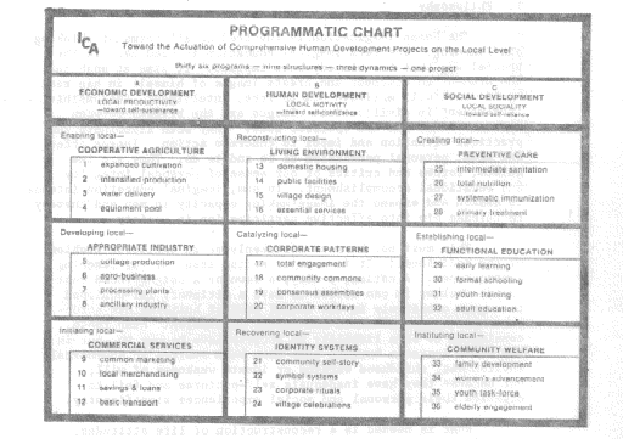 |
3. History
In 1976, the ICA completed the initiation of 24 pilot Human Development Projects across the world. It was in Maliwada India (one of the 24 pilot projects) that two approaches of the ICA were brought together: Imaginal Education and Community Reformulation. Out of these two approaches the Human Development Training School was conceived and developed, in order to respond to the concern for massive village renewal in the State of Maharashtra, India. There have been four schools taught per year in India since October of 1976 with a cumulative number of over 1000 graduates. These graduates now comprise the staff and directors in 160 rural villages that have replicated the pilot project in Maliwada. In addition to India's schools, one school was held in June, 1978 in Cano Negro, another pilot project site in Venezuela, 20 miles outside of Caracas, in order to train the directors and staff for four new projects in Latin America. Other schools have been held in Kwangyung I1, Korea, Sudtonggan, the Philippines and Fifth City Chicago in the United States.
1. Training
Two discoveries have proven to be fundamental to
the experience of human development training in all of the schools.
They are significant considerations in using the Human Development
Training Modules as an effective training tool for local communities.
First, it was discovered that the success of the training appears
to be closely related to it having taken place in a demonstration
setting that is representative of the possibility of comprehensive
community selfrenewal. In India, it was documented through
student experience and performance that working in a laboratory
relationship with the people and programs of the Maliwada Project
heightened the motivation of the students and therefore the effect
of the training experience. Second, because of the emphasis on
direct experience of a local community over a conceptual approach
to learning, it was discovered that the construct and design of
the training seems to equalize the potential of the students,
in spite of varying levels of socioeconomic background and
academic preparation. People who had completed the equivalent
of high school or college worked side by side with people who
were functionally illiterate. These discoveries offer promise
for a new form of education in local communities based on insight
into actual situations and the coalescing of available skills
to act on. They have guided the development of these modules.
2. Audience
The module is designed to coalesce a strategic mixture of people: social roles, levels of training and involvement in community development. The primary audience is concerned local residents who vary as the neighborhood itself varies, yet who have a common interest in the module arena of community life. Voluntary consultants and supporters of the community project as well as concerned resource people also attend. They acquire a better understanding of the community's needs for outside assistance as well as see the effectivity of their contribution as they work along with the community residents. Also present and closely related to the goals of the module is the project staff. Representatives from nearby communities concerned with development attend to gain insights on what methods allow diverse people to work effectively together and sustain their motivation. Such a wide spectrum of people in a community and its broader social structures working together is critical to the development of selfreliance.
The format of every module is the same. Its dynamics
are intended to produce new insight and action in its participants.
The major objectives of each session are to:
1. clarify the inclusive aspects of the module arena as it appears in a local community;
2. analyze the current status of the arena in the host community; communicate workable alternatives for effective action in the arena;
4. reveal the resources available to the host community;
5. formulate the above information into a committed plan of action; and
6. reflect on the overall [earnings of the module
for its future effectiveness.
The first session, the MODULE OVERVIEW inclusively
illustrates the substance of the arena in any local community.
It provides new and fresh images of what have come to be old problems.
It shows the scope and significance of the arena for the whole
community and gives examples of how particular issues within it
relate to the whole process of human development. By clarifying
the arena of concern and its importance, this presentation gives
participants a new perspective from which to view their development
efforts, often illuminating new approaches and alternate actions.
The second session, the FIELD VISIT takes community residents and outsiders on a tour of the host community, introducing them to the work already done in the module arena. The participants view this work firsthand where possible in relation to previous plans and accomplishments to date. This exercise gives new perspective to the issue of the module as participants begin to see what has already happened which can be used to advantage and other steps which need to be introduced. In addition, the interaction between community residents and outsiders enables the residents to articulate their accomplishments and [earnings and thereby clarify how the situation has actually changed since the program's initiation. This is a motivating factor in that it produces a new resolve in the community residents.
The third session, the IMPLEMENTATION TALK is a detailed
walk through of one or several efforts in the module arena. It
is the relating of practical experience by a person directly related
to the module arena involved in doing comprehensive community
development. The presentation relates case studies of successful
local programs, available technical schemes and tested strategies
and tactics which have proved effective. This presentation orients
the participants in a variety of "how to's" of implementation.
The fourth session, the RESOURCE PANEL gives the
participants new boldness in utilizing available resources. The
panel cuts through the sometimes overpowering mystique of governmental
agencies, business executives and technical experts by opening
a dialogue between local residents and people in these agencies
or businesses willing to help. This involves initial presentations
by panelists followed by a guided question and answer period.
The fifth session, the PRACTICAL WORKSHOP focuses on building a practical plan of action for a significant accomplishment in the module arena that would catalyze changes in the community beyond the module arena itself. The participants discuss the practical steps necessary to implement the plan, put them on a timeline and make assignments.
The six
The session, the PARTICIPANT EVALUATION provides a time of reflection for the participants to summarize their learnings from the module training. The group reflection allows the participants to discern the key learnings of the module for themselves as individuals. The group evaluation comments allow a broader perspective on the learnings. The written evaluation form serves as a tool for the module leaders to further develop the module content and methods for future use.
Community and neighborhood leadership benefit by
participation in the module in many ways. Community people who
attend the module receive practical suggestions, renewed motivity,
fresh sources of assistance and a concrete plan for the module
arena. The module arena is selected because a significant accomplishment
in this dimension will catalyze broad, sweeping change in the
community. In order for such changes to occur in a local community,
the leadership must see the task with new eyes, to remove past
preJudice and reduced goals and broaden ideas about future opportunities.
The following workshop is intended for use by the
module trainer with project leadership during the week prior to
the module to begin the process of considering fresh approaches.
The purpose of this workshop is to state the significant accomplishments
that have already happened locally in the module arena, locate
the current blocks preventing further progress and name the necessary
action that would facilitate visible change in three month's time.
I. HISTORY
What would you consider to be a significant accomplishment in the module arena?
What specific actions have been completed so far?
What individuals from the community, local agencies and the surrounding region have been involved in this work?
What would you say have been breakthrus, or new insights
in this area?
II. CURRENT BLOCKS
In what areas have you run into blocks
What seems to slow down progress?
What is the single obstacle which if dealt with would catalyze the community's
development?
III. THE "LEAP"
(significant accomplishment in the module arena for
catalyzing broad, sweeping change in the community)
What do you want to have happen to the community by the end of the month?
What are the key accomplishments that would occasion a "leap"?
Now can the module enable this?
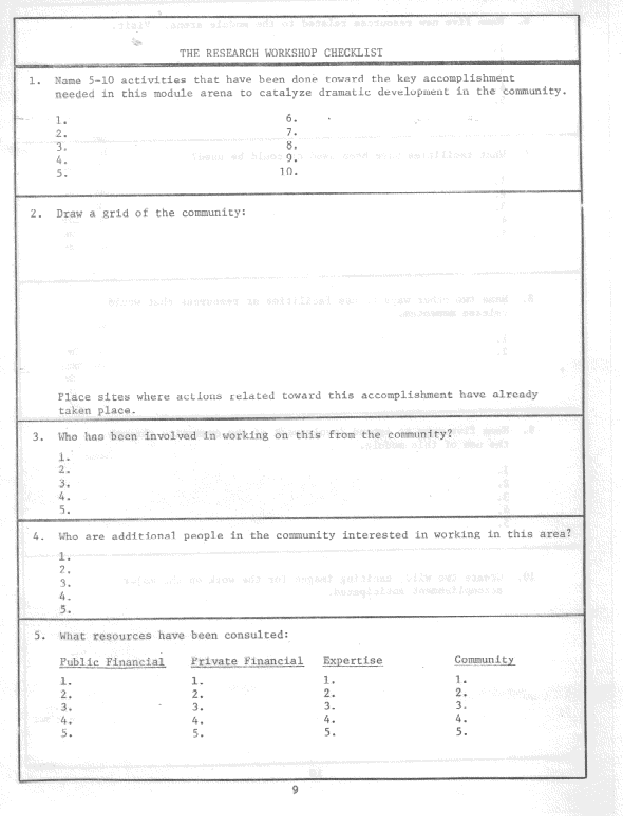 |
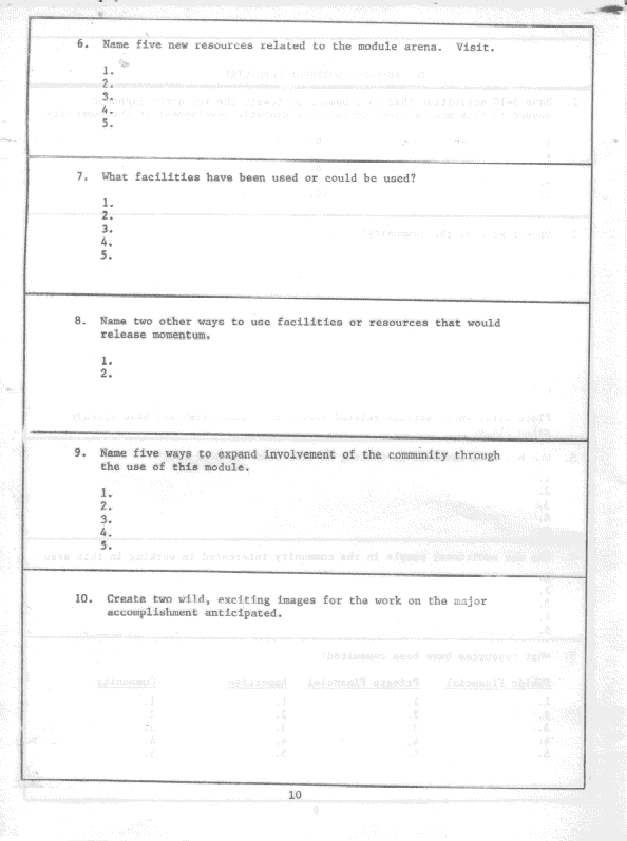 |
The module is designed to serve a diverse audience.
To ensure that invitations are extended to a comprehensive list
of potential participants list 10 names under each of the following
categories:
1. Local residents who work in the module arena
2. Persons from the metropolitan area, county and
state, who work in the arena both in public and private agencies.
3. Volunteer consultants and financial supporters
of the community project.
4. Other local residents who are concerned with their
community's development.
After getting out a comprehensive list of potential participants, determine how these people will be invited. Some can be sent invitations by mail with a phone call followup while others may need a personal visit. Followup by personal visits and telephone calls are necessary to answer questions, provide additional information and secure definite registrations. Publicity materials can be designed to reach a broader audience. News releases can be placed in local papers to give a brief description of the module and enrollment procedures. Fliers can be designed for mass distribution to provide information on the day. Doortodoor visitation within the local community can be organized through block clubs or other local organizations.
Adequate leadership of Human Development Training
Modules requires a team of people with various skills to fill
the basic roles throughout the day. Since an important aspect
of the training involves communicating corporate methods that
allow diverse people to work effectively together, the demonstration
of the leadership team's working together is crucial. One overall
coordinator familiar with Human Development Projects and skilled
in workshop methods is needed to orchestrate the day and, where
necessary, to train others for specific roles. One or two people
with direct experience in Human Development Projects are required
to do the two talks and to serve as resource people. It is preferable
for one of these to be from outside the host community because
of the objectivity and fresh insights possible from other experiences.
One or two people from local communities (not professionals or
staff, just local leaders) are also needed. At least one of these
needs to be from the host community to serve as emcee for the
day. This would be a basic team of 35 people. Prior to the
module this team would meet to make assignments to cover the following
roles: Host, Module Overview, Field Visit, Implementation Talk,
Panel Moderator and Workshop Leader. An important aspect of this
team is that it illustrate a range of role models including effective
orchestrator, local leadership and resource staff adequate to
the perspectives of the participants. In addition to this core
team, additional people will be needed (depending on the size
of the module) to lead field visits, subgroup discussions and
to serve as resource and practice staff.
The following are the specific tasks required for
each of the assigment roles:
Host: A community leader welcomes people to the module
and the project site.
Module Overview: This talk covers the whole module arena and is done by the
coordinator.
Field Visit: Community residents host module participants
for the field visit. If the group is large, they break into groups
of about twenty to facilitate the tour.
Implementation Talk: This talk is a testimony to the possibility of developing the module arena in any community, preferably done by a local resident who has been actively engaged in the project.
Panel Moderator: A member of the project staff introduces
the panel and makes sure that all questions are adequately answered.
This person should have questions on hand to keep the dialogue
moving.
Workshop Leader: This role may be played by anyone
with workshop training and experience to create the plan that
will be done by the community.
Lunch Preparation and Room Setup: These practical tasks are done by local residents and project staff.
1. Space Design
A meeting space which will accommodate 4060
persons is needed. Crlteria to be considered in the selection
are:
1. Adequate space to seat anticipated participants around tables.
2. A central location to facilitate the tour of the community in the morning session.
3. Easy access to a meal preparation and/or service area.
4. Free use of the space or minimal rental fee.
5. A location to which all residents of the community
will be willing to come.
Equipment and materials which are needed include:
1. Tables
2. Chairs
3. Blackboard, chalk, erasers
4. Butcher paper
5. Magic markers
6. Masking tape
7. Paper and pencils for participants
8. Decor items such as:
Community map Local symbols (e.g., community logos, flags) Photos of the community (before and after) Display of any industrial/commercial products Global map with other Human Development Projects marked on it.
9. Name tags
10. Ash trays
11. Food service equipment
12. Plastic garbage bags
2. Food Service
A hot lunch is served as a part of the module design.
In order to keep preparation and service time to a minimum, a
simple though substantial menu is in order. Past experience has
shown thatrestaurants and fast food chains are sometimes
willing to participate in the day by providing the meal with no
charge.
Coffee and doughnuts are served during the morning registration period. A simple "finger food" afternoon snack is also served. Coffee, tea, and a cold beverage are served at these times as well as at lunch.
The Community Welfare Module consists of six sessions
used in a one day consultation with a local community. These sessions
include: I Module Overview, II Field Visit, III
Implementation Talk, IV Resource Panel, V
Implementation Workshop and VI Participant Evaluation.
Each session includes the outlines for the lectures and the procedures
of the field visit, resource panel, and implementation workshop.
An evaluation form is included to provide feedback for the module
leadership for future module revisions.
The module time design is
8:30 Module Overview
9:45 Field Visit
11:00 Reflection on Field Visit
11:30 Break
12:00 Lunch and Implementation Talk
1:00 Resource Panel
2:30 Implementation Workshop
5:00 Participant Evaluation
CASE HISTORY: WELFARE
ACCOMPLISHMENT:
The Men's Club of Fifth City established a seven hour per night patrol of the community's streets in response to an overwhelming crime rate in the area. They were determined that life and property would be secure enough for effective community activity to take place. The Safe Streets Patrol carried no weapons, but communicated by twoway radio to alert police to crimes in progress. Cooperation with the police was secured and the crime rate was reduced by 35%.
PROBLEMS TO BE OVERCOME:
The pivotal issue to be addressed was the security
of buildings being rehabbed. A well organized criminal system
was able to remove whole kitchens immediately after they had been
installed. Local businessmen were determined to protect their
community! But this takes an investment. When the patrol was created
it faced the issues of funding, volunteer services, and authorization
by the police.
STEPS:
1. During a weeklong community planning consult the issue of safety and security was raised and a safe streets patrol was recommended.
2. One citizen's impassioned speech on his decision not to be driven out by crime and his voluntary signup for the safe streets patrol precipitated a decision by the Men's Club to take on Safe Streets as their ProJect.
3. The men bought their own CB radio, used their own cars, and paid for their own zas.
4. The Men's Club initiated fund raising disco dances.
5. An initial week of surveillance produced the capture of the "kitchen" thieves, the haulting of a theft and fire in the high school, and the discovery and hence life saving of a man pinned under his overturned car.
6. Visits with the police commander laid out the ground rules for the patrol e.g. no weapons, liquor, or intervention.
7. Visits by police and sheriff officials to Men's Club meetings built rapport and cooperative services with the police.
8. The Safe Streets Patrol became a chapter of REACT, patrolling a section of the Eisenhower~ Expressway.
RESOURCES:
The cost of the Safe Streets Patrol was met primarily through the private resources of the volunteers themselves. A small amount funds were raised through Community Discos. Both retired and working people participated in the nightly patrols.
FOLLOW THROUGH AND MAINTENANCE:
1. A schedule of drivers and base station attendants was set up on a rotating basis.
2. Continual proposal writing and fundraising is being done to secure funding.
3. A relationship with the police including reports was established.
4. Other services grew out of the patrol. The patrol set up a watch on houses where people were away for any period of time. It provided security for public events and offered a shuttle service for the public events, and offered a shuttle service for the elderly at these events.
5. The Safe Streets Patrol assisted in establishing
safety patrols in four other neighborhoods in Chicago.
48